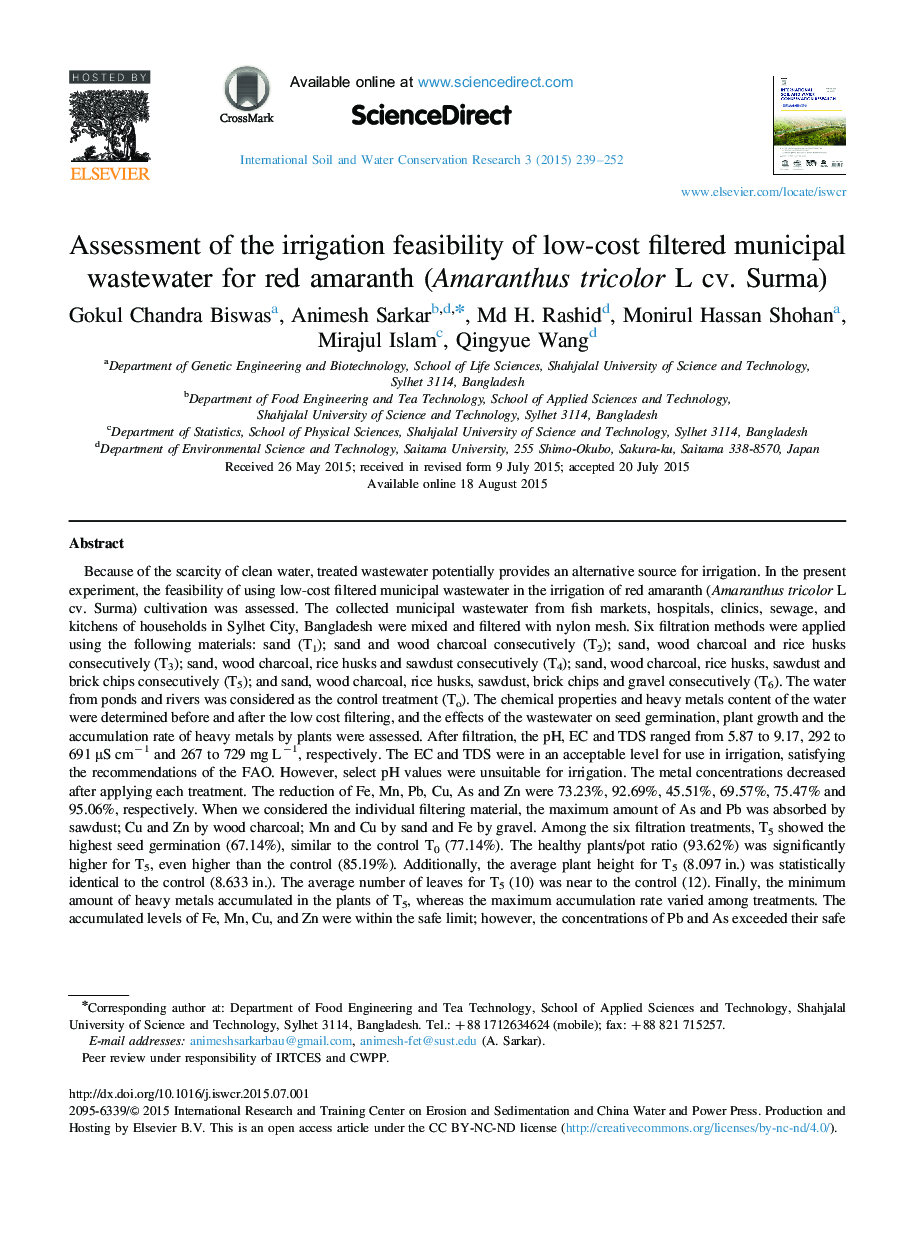| کد مقاله | کد نشریه | سال انتشار | مقاله انگلیسی | نسخه تمام متن |
|---|---|---|---|---|
| 4452086 | 1312021 | 2015 | 14 صفحه PDF | دانلود رایگان |

Because of the scarcity of clean water, treated wastewater potentially provides an alternative source for irrigation. In the present experiment, the feasibility of using low-cost filtered municipal wastewater in the irrigation of red amaranth (Amaranthus tricolor L cv. Surma) cultivation was assessed. The collected municipal wastewater from fish markets, hospitals, clinics, sewage, and kitchens of households in Sylhet City, Bangladesh were mixed and filtered with nylon mesh. Six filtration methods were applied using the following materials: sand (T1); sand and wood charcoal consecutively (T2); sand, wood charcoal and rice husks consecutively (T3); sand, wood charcoal, rice husks and sawdust consecutively (T4); sand, wood charcoal, rice husks, sawdust and brick chips consecutively (T5); and sand, wood charcoal, rice husks, sawdust, brick chips and gravel consecutively (T6). The water from ponds and rivers was considered as the control treatment (To). The chemical properties and heavy metals content of the water were determined before and after the low cost filtering, and the effects of the wastewater on seed germination, plant growth and the accumulation rate of heavy metals by plants were assessed. After filtration, the pH, EC and TDS ranged from 5.87 to 9.17, 292 to 691 µS cm−1 and 267 to 729 mg L−1, respectively. The EC and TDS were in an acceptable level for use in irrigation, satisfying the recommendations of the FAO. However, select pH values were unsuitable for irrigation. The metal concentrations decreased after applying each treatment. The reduction of Fe, Mn, Pb, Cu, As and Zn were 73.23%, 92.69%, 45.51%, 69.57%, 75.47% and 95.06%, respectively. When we considered the individual filtering material, the maximum amount of As and Pb was absorbed by sawdust; Cu and Zn by wood charcoal; Mn and Cu by sand and Fe by gravel. Among the six filtration treatments, T5 showed the highest seed germination (67.14%), similar to the control T0 (77.14%). The healthy plants/pot ratio (93.62%) was significantly higher for T5, even higher than the control (85.19%). Additionally, the average plant height for T5 (8.097 in.) was statistically identical to the control (8.633 in.). The average number of leaves for T5 (10) was near to the control (12). Finally, the minimum amount of heavy metals accumulated in the plants of T5, whereas the maximum accumulation rate varied among treatments. The accumulated levels of Fe, Mn, Cu, and Zn were within the safe limit; however, the concentrations of Pb and As exceeded their safe limits. The results showed that the low-cost filtration method potentially allows municipal wastewater to be used in irrigation for agricultural production.
Journal: International Soil and Water Conservation Research - Volume 3, Issue 3, September 2015, Pages 239–252